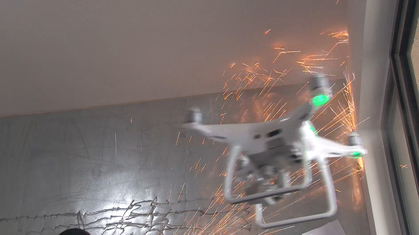-
From Current Issue
-
- Editor’s Letter Fire in the Heart
- Reviews I Gusti Ayu Kadek Murniasih
- Reviews 11th Seoul Mediacity Biennale: “One Escape at a Time”
- Dispatch Networked China
- One on One Monira Al Qadiri on Yukio Mishima
- Essays The rise of independent art spaces in pandemic-era Shanghai
- Features Tuan Andrew Nguyen
- Table of Contents
- Web Exclusives
- Archive
- Subscribe

R
E
V N
E
X
T
Installation view of LI MING’s Inspired by Transliteration—Chapter Three: Wavelength, 2018, single-channel video and sound installation: 18 minutes 58 seconds, dimensions variable, at “1703,” Antenna Space, Shanghai, 2018. All images courtesy the artist and Antenna Space.
At first glance, it seemed as if Li Ming’s first major show since winning the 2017 Hugo Boss Asia Art Award hadn’t been completely set up. In the foyer, a white door—unscrewed from apartment 1703, according to the black numbers stenciled onto it, and with a set of keys still dangling from the keyhole—was propped against the wall. A few monitors were strewn on the floor along a dim corridor leading to an area stacked with items wrapped in white paper. But the disordered scene was an evocation—more conceptual than physical—of Li’s studio, the show’s eponymous apartment 1703. Free to wander between five installations, visitors could intuit that the gallery’s layout, with passageways used for storage, and spaces deprived of natural light, was a schema for the apartment.
Down a corridor was “《Feedback》”, Volume 1 (all works 2018), a five-channel work on flat monitors. On one of the screens, the artist is shown fine-tuning a configuration similar to the installation. By introducing another camera he creates an infinite loop within the medium’s closed-circuit system, its output fed back into the screen, harking back to the earliest experiments in video art, such as Nam June Paik’s TV Cross (1966). Li adds a time delay to the hermetic scenario, producing moving mandala-like patterns that, due to the temporal rift, are hard to reconcile visually with the artist’s manual adjustments—a disjuncture that imbues Li’s activity with the mystery of a private ritual.
Similarly strange alchemy was witnessed in Channel, a fly-on-the-wall video using split screens to show up to nine scenes simultaneously, revealing a plethora of activities occurring in Li’s studio that, when played at the same time, is overwhelming. In one section of the screen, power tools generate dramatic showers of sparks as they engrave lines onto a silver surface, while ambient sound drifts in and out of sync. A drone camera gave a weightless perspective, hovering around the space and occasionally making forays out of the window to provide a dizzying view of the whole building and the river beyond—revealing that the studio in the video isn’t in Shanghai at all, but rather overlooks the Qiantang River. In Channel, the artist’s actions appear realistically presented through ostensibly unaltered sound and image, but the multiplicity of disorienting perspectives and lack of narrative context render even ordinary activities obscure.
Still from LI MING’s Inspired by Transliteration—Chapter Three: Wavelength, 2018, single-channel video and sound installation: 18 minutes 58 seconds, dimensions variable.
Taking up an entire wall in the same room was a video projection Inspired by Transliteration—Chapter Three: Wavelength, showing Li striding along the Qiantang River’s flood defenses, seen in the drone camera footage in Channel. The montage contrasts urban civil engineering to pastoral scenes with close-ups of a white horse, intermittently cutting to shots of the Qiantang’s well-known natural wonder—a tidal surge that sends majestic waves crashing against the bank, the sound of which is popularly described as a thousand horses galloping. However, the docile horse in the video defies this dramatic association, and Li’s stroll along the dangerous path of the flood barrier is at a time when the river is at rest, the montage implying that the apartment itself spreads a benign influence on its surroundings.
At the end of the dark corridor was a space bathed in natural light, providing a view of the Suzhou River, which runs through Shanghai, relating the outlook to the view of Qiantang River, seen in the other installations. Here, a work titled <Record> comprised a pile of arcane wrapped objects, the monitor nestled among them showing footage of them being wrapped, as the sound of adhesive tape unfurling plays continuously. One of the packages is torn, revealing the engraved silver material previously seen being worked with an angle grinder in Channel. Presumably, the packages in <Record> are the tangible outcomes of the processes that have been shown taking place in the apartment, now ready for distribution.
The components of art-making were laid bare in “1703”—inspiration from nature, seen in Li’s promenade by the river; experimental research with video effects; manipulation of materials in his workshop; and the finishing touches before distribution. Even banal acts, such as packing, were accorded the status of uplifting creativity. Yet, in keeping the finished products enticingly (and literally) under wraps, Li refrains from offering a concrete definition of art, instead presenting it as an enigma for the viewer to decipher. “1703” is a similarly fluid concept, its only demand, the belief that an ordinary home can be a transcendent place in which creativity can blossom.
Li Ming’s “1703” is on view at Antenna Space, Shanghai, until May 4, 2018.
To read more of ArtAsiaPacific’s articles, visit our Digital Library.







